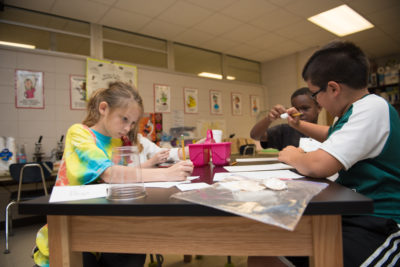Searcy, AR. (LP) — Therapy dogs have been active in schools for some time. Teachers and administrators have witnessed the effects therapy dogs have on students and themselves. While therapy dogs have calming effects and reduced stress levels in most students, children with disabilities can present a unique challenge. Because of the wide range of intensity, behaviors can be unpredictable. Therapy dogs can reduce the effect of this allowing a child with autism to feel more at ease and open to social behavior. Researchers have found that children with autism are more social when playing with therapy dogs as opposed to toys. New research offers further proof that animals can also have a therapeutic effect. A therapy dog can lift moods in the classroom, often provoking laughter. The therapy dog is also there to offer friendship and a shoulder to lean on for students.

Melanie Maples, teacher at Southwest Middle School states, “In my opinion, a therapy dog in the classroom would probably cause students to be distracted. However, individual students and animals are all different, so it would depend on the class and the dog.”
Considering that dogs can be therapeutic, they are used with children who suffer tragedy. All too often we hear about a tragedy at a school that makes national news. What many of us do not hear very often is how the students and community were helped by therapy dogs. Therapy dogs were deployed when 26 people — 20 students and six adults — were shot and killed at the Sandy Hook Elementary School in Newtown, Connecticut. The devastation was felt not only within the Sandy Hook community but through the United States. Therapy dogs were among the first responders to the aftermath of the shooting. Overwhelmed children and parents said that petting the dogs gave them relief from their sadness. Therapy dogs were also introduced to Virginia Tech campus in Blacksburg, Virginia to aid and comfort the faculty, staff and student body to help cope with the tragedy of the loss of 32 people. Often, we don’t know the tragedy that children go through at home. So offering relief at school using the therapy dogs could be a positive thing.
Melanie says, “Dogs have a calming effect on those who are able to sit and pet or play with them, so I definitely believe this has a positive effect on mental health.” Administrators and teachers can face a lot of barriers in seeking to adopt new programs, and not surprisingly, can be resistant to changing or altering current programs. Bringing dogs into schools can be seen as risky and loaded with concerns about potential liability. Implementing an animal facilitated therapy program will take work, coordination and support from various sources. However, the benefits to students, teachers and the administration have been shown to be well worth it.

Luke Smith, a student at SouthWest Middle School states, “When I see a little puppy, I always forget about everything that makes me upset and I feel happy and loved. I look forward to seeing my dog when i get back at school.” Making students happy and keeping them there is a good way to bring in more motivation and improve attendance.
Just like everything, there are cons to having a therapy dog in school. It’s hard to believe that some people may not support therapy dogs in schools. The fact is that dogs are not for everyone. One big concern is the cost of the therapy dog. There is training needed for the human who will be with the pup. In addition to this, the dog needs to be fed, housed, and kept healthy. All of this maintenance needs to be considered when taking on this big responsibility. We need to consider people who have severe canine allergies. How will this be addressed if a child or faculty member is allergic? Another concern is the fear of dogs. Many people are very afraid of dogs. Bringing them into the classroom and school as a whole may be more alarming to them. Rather than assisting them, it will increase their anxiety.
One plausible solution to many of these problems, as Melanie suggests is, “A school counselor could house a therapy dog in his/her office to use as needed for students.” This would be a good way for students to have alone time with the dog rather than with the whole class around because that could cause conflict.
Smith states, “I would feel better talking to a dog about how I’m feeling by myself instead of talking to a teacher or a kid because the dog can’t tell anybody what I say. When I get mad at something, I go lay with Apollo.” With the okay from administration in the school, bringing in a therapy dog for kids to bond with would be an amazing way to show love to the kids and to express that their mental health matters in education.
